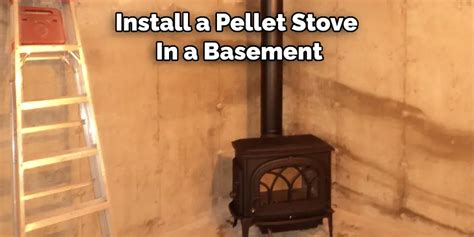How To Install A Pellet Stove In Basement
Ronan Farrow
Apr 01, 2025 · 4 min read

Table of Contents
How to Install a Pellet Stove in Your Basement: A Comprehensive Guide
Installing a pellet stove in your basement can be a rewarding project, offering supplemental heat and a cozy ambiance. However, it's crucial to understand the process thoroughly before you begin. This guide will walk you through the essential steps, emphasizing safety and compliance with local building codes. Remember, always consult with qualified professionals for permits and inspections. This guide is for informational purposes only and shouldn't replace professional advice.
I. Planning and Preparation: The Foundation of a Successful Installation
Before you even think about unpacking your pellet stove, meticulous planning is key. This phase significantly impacts the safety and efficiency of your installation.
A. Assessing Your Basement's Suitability
- Space Requirements: Ensure you have adequate space for the stove, including sufficient clearance around all sides as specified by the manufacturer's instructions. This usually involves several feet of clearance from combustible materials. Measure twice, cut once! Incorrect measurements lead to potential fire hazards.
- Electrical Requirements: Pellet stoves require a dedicated electrical circuit. Confirm you have the necessary amperage and voltage. Consult an electrician if you're unsure.
- Ventilation: Proper ventilation is absolutely critical. Pellet stoves exhaust gases, and inadequate ventilation can lead to carbon monoxide poisoning. You'll need a correctly sized and appropriately located vent pipe that extends to the outside.
- Floor Protection: Pellet stoves can be heavy. Ensure your basement floor can handle the weight. You may need to reinforce the floor or use a fire-resistant pad underneath the stove.
- Fuel Storage: Plan where you'll store your pellet fuel. Store it in a dry, well-ventilated area away from the stove to prevent moisture and potential fire hazards. Never store pellets near the stove itself.
B. Obtaining Necessary Permits and Inspections
- Permits: Contact your local building department to obtain the necessary permits before starting any installation work. This ensures compliance with local building codes and safety regulations. Ignoring this step can lead to significant fines.
- Inspections: Schedule inspections at the appropriate stages of the installation process. These inspections help to ensure that everything is installed correctly and safely.
II. The Installation Process: A Step-by-Step Guide
With your planning complete, you can begin the installation. Remember, safety is paramount. Proceed cautiously and always refer to your stove's manufacturer's instructions.
A. Vent Pipe Installation
- Routing: Carefully plan the vent pipe route, ensuring a smooth, continuous path with minimal bends. The vent pipe must terminate outside, well above ground level and away from any potential obstructions.
- Installation: Connect the vent pipe sections securely, ensuring airtight seals. Use appropriate sealing materials as recommended by the manufacturer.
- Inspection: Once the vent pipe is installed, have it inspected by a qualified professional to verify proper installation and compliance with regulations.
B. Stove Installation
- Positioning: Place the stove in its designated location, ensuring it meets the required clearance distances from walls and other combustible materials.
- Electrical Connections: Connect the stove to its dedicated electrical circuit, ensuring proper grounding. Do not attempt this if you are not comfortable with electrical work.
- Fuel Hopper: Fill the fuel hopper with pellets according to the manufacturer's instructions.
C. Testing and Operation
- Initial Startup: Follow the manufacturer's instructions carefully for the initial startup. Allow the stove to operate for a while to ensure proper function and to check for any leaks or issues.
- Carbon Monoxide Detector: Install a battery-powered carbon monoxide detector near the stove. This is critical for safety. Never rely solely on visual indicators.
III. Ongoing Maintenance and Safety
Proper maintenance is crucial for the longevity and safety of your pellet stove.
- Regular Cleaning: Regularly clean the ash pan, the stove's interior, and the vent pipe to ensure efficient operation and prevent potential fire hazards.
- Annual Inspection: Schedule an annual inspection by a qualified professional to check for any issues and ensure the stove is operating safely and efficiently.
By following these steps and prioritizing safety, you can successfully install a pellet stove in your basement and enjoy the warmth and ambiance it provides. Remember, seeking professional assistance when needed is not a sign of weakness, but rather a commitment to safety and a successful installation.
Featured Posts
Also read the following articles
| Article Title | Date |
|---|---|
| How To Install A Baby Trend Car Seat | Apr 01, 2025 |
| How To Make A Dog Crate Escape Proof | Apr 01, 2025 |
| How To Hang Curtains For Sliding Glass Door | Apr 01, 2025 |
| How To Open A Speakeasy | Apr 01, 2025 |
| How To Pickle Hot Cherry Peppers | Apr 01, 2025 |
Latest Posts
Thank you for visiting our website which covers about How To Install A Pellet Stove In Basement . We hope the information provided has been useful to you. Feel free to contact us if you have any questions or need further assistance. See you next time and don't miss to bookmark.
